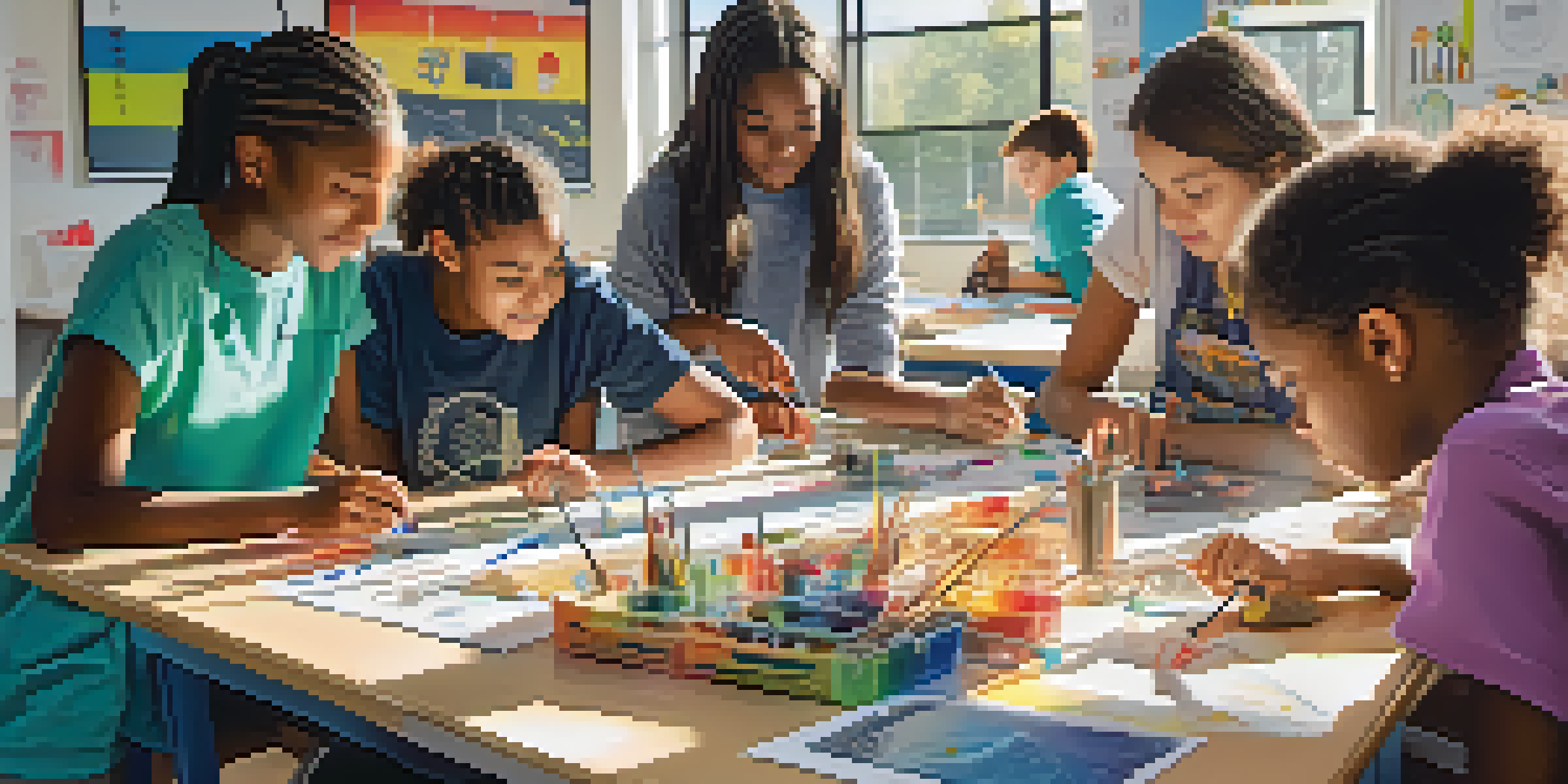Teaching STEAM: Strategies for Engaging Diverse Learners

Understanding the Importance of STEAM Education
STEAM education, which integrates Science, Technology, Engineering, Arts, and Mathematics, is crucial for preparing students for a rapidly changing world. By blending these disciplines, we foster critical thinking, creativity, and problem-solving skills. This holistic approach not only engages students but also encourages them to see the connections between different subjects, making learning more meaningful.
Education is not the filling of a pail, but the lighting of a fire.
In today's diverse classrooms, it's vital to recognize that students come from various backgrounds and have unique learning styles. This diversity can enrich the learning experience, as different perspectives lead to innovative solutions and ideas. Embracing STEAM means creating a curriculum that is inclusive and accessible, allowing every student to contribute and thrive.
Moreover, STEAM education can inspire students to pursue careers in fields that are often underrepresented. By engaging diverse learners early on, we can ignite their interest in these areas and help bridge the gap in representation. This not only benefits individual students but also enriches our society with a broader range of ideas and innovations.
Fostering a Growth Mindset in Students
A growth mindset, the belief that abilities can be developed through dedication, is essential for success in STEAM fields. Encouraging students to embrace challenges and learn from failures helps them build resilience. This mindset empowers them to tackle complex problems, a crucial skill in STEAM disciplines where trial and error often lead to breakthroughs.

Teachers can cultivate a growth mindset by praising effort over innate talent. For instance, instead of saying 'You're so smart,' try 'I’m impressed by how hard you worked on that project.' This subtle shift reinforces the idea that perseverance and effort lead to improvement, making students more likely to take on challenging tasks in the future.
STEAM Education Enhances Learning
Integrating Science, Technology, Engineering, Arts, and Mathematics fosters critical thinking and creativity among students.
Additionally, incorporating real-world challenges into the curriculum can further enhance this mindset. When students see the relevance of their work and understand that both successes and failures are part of the learning process, they become more engaged and motivated. This approach not only teaches them academic content but also essential life skills.
Utilizing Hands-On Learning Experiences
Hands-on learning is a powerful way to engage diverse learners in STEAM education. Activities like experiments, building projects, and interactive simulations allow students to explore concepts actively rather than passively absorbing information. This experiential approach caters to different learning styles, ensuring that all students can connect with the material.
The only way to do great work is to love what you do.
For example, in a science class, students might conduct experiments to understand chemical reactions rather than just reading about them in a textbook. This type of learning not only makes the subject matter more engaging but also helps students retain information better. When they actively participate in their learning, they are more likely to develop a genuine interest in the subject.
Moreover, hands-on learning encourages collaboration among students, fostering teamwork and communication skills. When working together on projects, students learn to respect diverse opinions while also honing their problem-solving abilities. This collaborative environment not only enriches the learning experience but also prepares them for future endeavors in both academic and professional settings.
Incorporating Technology to Enhance Learning
Technology plays a pivotal role in modern education, especially in STEAM. By integrating tools such as coding platforms, virtual simulations, and interactive software, teachers can create engaging and dynamic learning environments. These resources allow students to explore complex concepts at their own pace, catering to diverse learning needs.
For instance, using coding software can introduce students to programming in a fun and accessible way. They can learn by creating their own games or animations, which not only solidifies their understanding of programming principles but also sparks creativity. When students can see the immediate results of their work, their motivation and engagement levels often increase significantly.
Growth Mindset Boosts Resilience
Encouraging a growth mindset helps students embrace challenges and learn from failures, essential for success in STEAM fields.
Furthermore, technology enables teachers to reach students beyond the classroom walls. Online resources and collaborative platforms facilitate communication and project collaboration among students from different backgrounds. This expanded access to learning materials and peers enriches the educational experience, allowing diverse learners to thrive.
Differentiating Instruction for Varied Learning Styles
Differentiated instruction is key to meeting the diverse needs of learners in STEAM education. By tailoring lessons to accommodate different learning styles—visual, auditory, kinesthetic, and more—teachers can ensure that every student has the opportunity to succeed. This approach not only enhances understanding but also boosts student confidence.
For example, a teacher might present a concept through a video (visual), a group discussion (auditory), and a hands-on experiment (kinesthetic). By providing multiple pathways for understanding, students can engage with the material in ways that resonate with them. This flexibility allows them to take ownership of their learning journey.
Moreover, differentiation encourages students to collaborate with peers who may have different strengths. Working together on projects allows them to learn from one another, creating a richer educational experience. This not only promotes inclusivity but also prepares students for the collaborative nature of many STEAM careers.
Creating an Inclusive Classroom Environment
An inclusive classroom environment is essential for engaging diverse learners. By fostering a sense of belonging, teachers can create a space where all students feel valued and empowered to participate. This can be achieved through culturally relevant teaching practices that reflect the diverse backgrounds of students.
For instance, incorporating multicultural perspectives into STEAM lessons helps students see themselves in the curriculum. When they recognize that their own experiences and cultures are reflected in the material, they are more likely to engage with it. This connection can spark curiosity and drive students to explore subjects more deeply.
Hands-On Learning Engages Students
Experiential learning through hands-on activities allows students to actively explore concepts, catering to diverse learning styles.
Additionally, establishing clear expectations and norms that promote respect and collaboration is vital. Creating a classroom culture that celebrates diversity encourages students to share their thoughts and ideas without fear of judgment. This inclusive atmosphere enhances learning and fosters positive relationships among students.
Assessing Learning in Diverse Ways
Assessment is a crucial aspect of education, and in a STEAM context, it should be as diverse as the learners themselves. Traditional testing may not accurately reflect a student's understanding or abilities. Therefore, incorporating various assessment methods—such as projects, presentations, and portfolios—can provide a more comprehensive view of student learning.
For example, instead of a standard test, a teacher might ask students to work on a group project that demonstrates their understanding of a concept. This approach not only assesses their grasp of the material but also evaluates their collaboration and communication skills. By focusing on different aspects of learning, teachers can better understand each student's strengths and areas for growth.

Moreover, providing opportunities for self-assessment encourages students to reflect on their own learning. By setting personal goals and evaluating their progress, they take ownership of their education. This practice not only builds self-awareness but also motivates students to strive for improvement, fostering a lifelong love of learning.